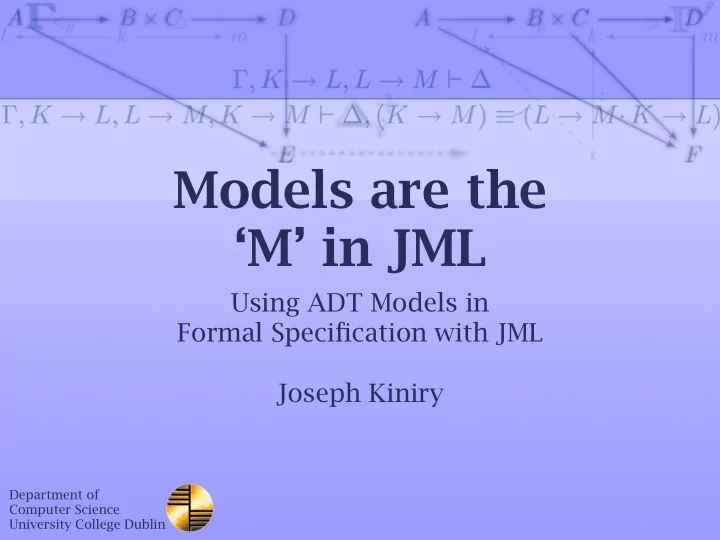

Models are the ‘M’ in JML Using ADT Models in Formal Specification with JML Joseph Kiniry Department of Computer Science University College Dublin
Models, not Modeling the ‘M’ in JML is not the same as the ‘M’ in UML, even if both use the term ‘model’ JML models are mathematical abstractions UML models are pretty pictures JML models are used to specify abstract behavior independent of implementation an implementation realizes a model and is verified as fulfilling the model Department of Computer Science 2 University College Dublin
Standard Models standard mathematical models include: bag, list, map, pair, relation, sequence, set variants exist for values and objects standard Java models include: Byte, Char, Double, Float, Integer, Long, Short, String, Type Collection, Comparable, Enumeration, Iterator Department of Computer Science 3 University College Dublin
Mathematical Models each model is realized by one Java class see the package org.jmlspecs.models all methods of all models are functional each model has a full specification spec is in OO/ADT style algebraic equational axiomatic spec NB no models have been verified yet! Department of Computer Science 4 University College Dublin
Java Models all core classes have models some of these models are quite simple (e.g., Byte, Char, Integer, and String) others are quite complicated (e.g., Double and Float) Department of Computer Science 5 University College Dublin
Using Models models are used by declaring model fields one can also declare model methods in specifications, models are used in lieu of concrete fields when at all possible in implementations, models are bound to implementations with a represents clause representations can be concrete fields or abstract pure method invocations Department of Computer Science 6 University College Dublin
Example Models: JMLString public /*@ pure @*/ class JMLString implements JMLComparable { /** The contents of this object. */ //@ public model String theString; //@ public invariant theString != null; protected String str_; //@ in theString; //@ protected represents theString <- str_; //@ protected invariant str_ != null; Department of Computer Science University College Dublin
Example Models: JMLInteger public /*@ pure @*/ class JMLInteger implements JMLComparable { /** The integer value of this object. */ //@ public model int theInt; //@ public constraint theInt == \old(theInt); private int intValue; //@ in theInt; //@ private represents theInt <- intValue; Department of Computer Science University College Dublin
JMLInteger’s remainderBy() /** Return a new object containing the remainder of this object's * integer value divided by that of the given argument. */ /*@ public normal_behavior @ requires i2 != null && !i2.equals(new JMLInteger(0)); @ ensures \result != null @ && \result.theInt == theInt % i2.theInt; @*/ public /*@ non_null @*/ JMLInteger remainderBy(/*@ non_null @*/ JMLInteger i2) { //@ assume i2.intValue != 0; return new JMLInteger(intValue % i2.intValue); } Department of Computer Science University College Dublin
Issues with Models awkward to use all operators are functional and are methods, thus an unfamiliar prefix- notation is necessary all mathematical models are parameterized on a type, but since Java <=1.5 has no parameterized classes, casting is frequent execution speed with jmlrac is very slow particularly true of mathematical models Department of Computer Science 10 University College Dublin
Verifying with Models models with built-in types and functional representations work in ESC/Java2 small models with richer types and functional representations sometimes work primarily complexity issue with Simplify medium to large models with richer types do not work at all currently revising core specifications to match ESC/Java2’s current capabilities Department of Computer Science 11 University College Dublin
Recommend
More recommend